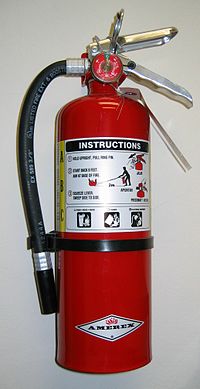
Photo from wikipedia
AbstractDry powder fire-extinguishing agent is one of Halon substitutes due to its superior fire-extinguishing performance, non-toxicity, and environmental friendliness. As one of the most widely used dry powders, ABC dry… Click to show full abstract
AbstractDry powder fire-extinguishing agent is one of Halon substitutes due to its superior fire-extinguishing performance, non-toxicity, and environmental friendliness. As one of the most widely used dry powders, ABC dry powder has attracted wide attention. Understanding its reaction mechanism is important to the design of more efficient compound dry powder based on it. When ABC dry powder was applied to the flame, ammonium dihydrogen phosphate (the main fire-extinguishing component of ABC dry powder) would rapidly decompose into phosphoric acid (H3PO4) and ammonia. Therefore, in order to figure out the chemical reaction mechanism of ABC dry powder and active radicals, the main focus of this paper is on the H3PO4. Analysis of the electrostatic potential on van der Waals surface of H3PO4 was carried out. Besides, detailed theoretical investigation has been performed on the mechanism, kinetics, and thermochemistry of the reactions of H3PO4 with H, OH, and CH3 radicals and further decomposition of H3PO4 using M06-2X/6-311G(d,p)//CCSD(T)/cc-pVTZ level of theory. Mayer bond order for all intrinsic reaction coordinate points was also calculated. Finally, it is theoretically proved that ABC dry powder extinguishes the fire mainly by chemical inhibition on H and OH radicals. Grapical Abstract.
Journal Title: Journal of Molecular Modeling
Year Published: 2019
Link to full text (if available)
Share on Social Media: Sign Up to like & get
recommendations!